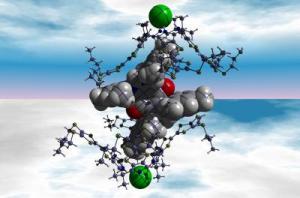Sep 16 2010
The development of new organic batteries—lightweight energy storage devices that work without the need for toxic heavy metals—has a brighter future now that chemists have discovered a new way to pass electrons back and forth between two molecules.
The research is also a necessary step toward creating artificial photosynthesis, where fuel could be generated directly from the sun, much as plants do.
University of Texas at Austin chemists Christopher Bielawski and Jonathan Sessler led the research, which was published in Science.
 This is an illustration of an assembled set of different molecules. These molecules meet, exchange electrons and then disassemble because chloride ions, which are represented as green spheres, are present. If these chloride ions are removed, the entire process can be reversed.
This is an illustration of an assembled set of different molecules. These molecules meet, exchange electrons and then disassemble because chloride ions, which are represented as green spheres, are present. If these chloride ions are removed, the entire process can be reversed.
When molecules meet, they often form new compounds by exchanging electrons. In some cases, the electron transfer process creates one molecule with a positive charge and one molecule with a negative charge. Molecules with opposite charges are attracted to each other and can combine to form something new.
In their research, the chemists created two molecules that could meet and exchange electrons but not unite to form a new compound.
"These molecules were effectively spring-loaded to push apart after interacting with each other," says Bielawski, professor of chemistry. "After electron transfer occurs, two positively charged molecules are formed which are repelled by each other, much like magnets held in a certain way will repel each other. We also installed a chemical switch that allowed the electron transfer process to proceed in the opposite direction."
Sessler adds, "This is the first time that the forward and backward switching of electron flow has been accomplished via a switching process at the molecular scale." Sessler is the Roland K. Pettit Centennial Chair in Chemistry at The University of Texas at Austin and a visiting professor at Yonsei University.
Bielawski says this system gives important clues for making an efficient organic battery. He says understanding the electron transfer processes in these molecules provides a way to design organic materials for storing electrical energy that could then be retrieved for later use.
"I would love it if my iPhone was thinner and lighter, and the battery lasted a month or even a week instead of a day," says Bielawski. "With an organic battery, it may be possible. We are now starting to get a handle on the fundamental chemistry needed to make this dream a commercial reality."
The next step, he says, is to demonstrate these processes can occur in a condensed phase, like in a film, rather than in solution.
Organic batteries are made of organic materials instead of heavy metals. They could be lightweight, could be molded into any shape, have the potential to store more energy than conventional batteries and could be safer and cheaper to produce.
The molecular switch could also be a step toward developing a technology that mimics plants' ability to harvest light and convert it to energy. With such a technology, fuel could be produced directly from the sun, rather than through a plant mediator, such as corn.
"I am excited about the prospect of coupling this kind of electron transfer 'molecular switch' with light harvesting to go after what might be an improved artificial photosynthetic device," says Sessler. "Realizing this dream would represent a big step forward for science."
Source: http://www.utexas.edu/